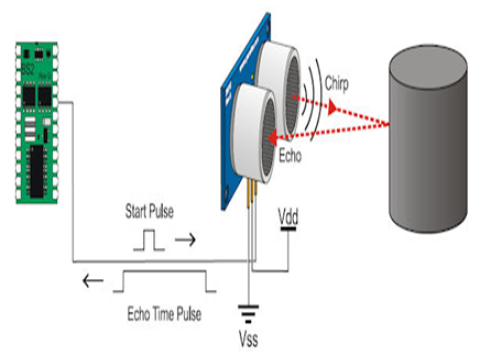Ultrasonic sensors detect or measure objects by emitting and receiving high-frequency sound waves (ultrasound). Operating in the 100–400 kHz range, they rely on the time it takes for an ultrasonic pulse to travel to an object (liquid surface or moving target) and return. Their reliability and versatility make them valuable for tasks ranging from continuous level measurement in tanks to motion detection in security or lighting systems. Below, we outline their fundamental working principles, major sensor types, and application areas.
1. How Ultrasonic Sensors Work
1.1 Principle of Operation
An ultrasonic sensor typically consists of:
- Emitter (Transducer): Generates a high-frequency sound wave (generally in the 100–400 kHz range).
- Receiver (Microphone or Transducer): Captures the echo from the target or liquid surface.
- Signal Processing Electronics: Measures the time of flight or Doppler shift and outputs a corresponding electrical signal.
Sound at ultrasonic frequencies is inaudible to humans. By analyzing factors like travel time or frequency shift, the sensor infers distance or movement.
1.2 Key Advantages
- Contactless Sensing: No direct contact with the target or fluid, reducing maintenance and contamination.
- Reliability in Harsh Environments: Many models resist dust or humidity, thanks to sealed transducer designs.
- Versatile Output Options: Available with analog signals, digital communications, or simple switch outputs.
1.3 Potential Drawbacks
- Sensitivity to Materials: Highly absorbent or angled surfaces can scatter sound waves, affecting accuracy.
- Affected by Air Turbulence: Wind or significant air movement can distort ultrasonic signals, reducing stable readings in outdoor conditions.
2. Ultrasonic Level Sensors
2.1 Measuring Liquid Levels
When mounted above a liquid, ultrasonic level sensors send pulses downward and measure return time (Time-of-Flight):
By subtracting this distance from the tank’s total height, the system infers the liquid level. Typical measurement ranges span from a few centimeters to several meters (e.g., up to 8–10 m), depending on model and environment.
2.2 Pros & Cons for Level Measurement
Pros:
- No Moving Parts: Compared to floats or mechanical switches, ultrasonic sensors require minimal maintenance.
- Good Accuracy: Error margins can be around 1%.
- Suitable for Various Liquids: Water, oils, fuels—provided no heavy foam or extreme vapors.
Cons:
- Foam or Splashing: Can dampen echoes, causing erratic readings.
- Wind or Vapor Influence: Outdoor or high-temperature conditions might require protective still pipes or advanced compensation algorithms.
2.3 Example Uses
- Tanks & Silos: Continuous fill-level monitoring in water treatment plants, agricultural setups, or chemical storage.
- Sumps & Wells: Monitoring water depth for pump control or flood prevention.
- Industrial Processes: Tracking fluid consumption, logging usage data.
3. Ultrasonic Motion Sensors
3.1 Doppler-Based Movement Detection
An ultrasonic motion sensor sends continuous or pulsed high-frequency signals and detects Doppler shifts in the echoes. When an object moves within its detection zone, the reflected wave changes in frequency, indicating motion.
- Common Range: Typically up to ~10 meters indoors.
- Zone Shape: Often conical or elliptical volume coverage.
3.2 Benefits over Infrared
- Immune to Thermal Changes: Drafts or HVAC vents don’t cause false alarms.
- Resistant to Light Interference: Not affected by bright sunlight or glare.
3.3 Usage Examples
- Security Systems: Intrusion detection in warehouses or large rooms.
- Automatic Lighting: Hallways or staircases, turning lights on only upon occupant movement.
- Industrial Safety: Machine safety lockout if a person enters restricted zones.
4. Sensor Configurations
4.1 Single-Housing (Diffuse) vs. Through-Beam
Single-Housing (Diffuse): Emitter and receiver are co-located; the sensor reads the reflection from the target (liquid surface or object). They’re common in level measurement or short-range detection.
Through-Beam: Transmitter and receiver reside in separate housings. The object or fluid interrupts or reflects the ultrasonic wave. Typically used for linear detection or precise distance measurement.
4.2 Reflector-Style
Some ultrasonic sensors incorporate a dedicated reflector to stabilize detection. This approach can enhance accuracy by providing a consistent reference echo.
5. Key Parameters to Consider
- Measurement Range: Check min and max distances for your application. Using two sensors may be necessary for extremely wide spans.
- Output Format: Options may include analog (4–20 mA, 0–10 V), digital (serial, I²C), or simple switch (on/off).
- Environmental Conditions: Excessive foam, vapor, wind, or extreme temperatures might degrade performance.
- Mounting Requirements: Ensuring the sensor’s beam has a clear path to the fluid surface or detection zone.
6. Practical Tips
- Positioning: Keep the sensor perpendicular to the liquid surface or movement zone for stable echoes.
- Surface Turbulence: If water is agitated, readings can fluctuate; using a stilling tube or damping mechanical movements might help.
- Beam Angle & Blind Zone: Account for near-field distance where the sensor may not detect accurately, typically several centimeters from the transducer.
- Regular Calibration: Verifies accuracy, especially in industrial or high-precision environments.
Conclusion
Ultrasonic sensors utilize sound waves beyond human hearing to measure distance or detect motion. In level measurement, they send pulses toward a fluid and read back the echo time. For motion sensing, they analyze Doppler frequency changes to detect movement. Offering robust, non-contact operation, ultrasonic sensors are integral to automated control systems—managing liquid levels, enabling smart lighting, and securing facilities.
For best results, select models and mounting approaches suited to your environment, factoring in distances, potential foam or wind, and desired output signals. At safsale.com, we can guide you in choosing the right ultrasonic sensor solution, ensuring high reliability and precision for your applications.

